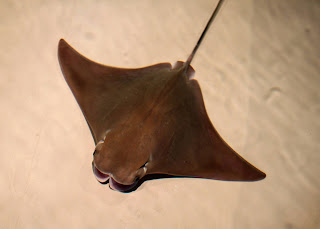Blog Number 5; 5/14/2021; School Time!
One of the aspects that
makes the glades so beautiful is that it is not just a
terrestrial ecosystem, but an aquatic one as well, surrounded by open
seas, shallows waters, and coral reefs. The reefs are extremely important to
the protection of the Everglades. When hurricanes form, the coral reefs act as
a "storm barrier", protecting us from the initial, harsher impact of
the storm. This is why we must study its inhabitants to check upon its health.
When I think of sharks, one strange group always comes to mind, the hammerheads. They seem like a reconstruction of a fossil that makes us think, "it didn't look like that" such as Opabinia (side note those were ancient aquatic invertebrates with a trunk and five pultruding eyes). However, it very much indeed looks like that. I will be talking about the most common species of hammerhead in Florida, the scalloped hammerhead. These animals are known for actually for living and migrating in large schools called, "shivers", of 100 or more individuals. These usually consists of young males and females. At night, they go from the reefs and shores to the deep sea to hunt in packs, which is unusual amongst sharks. The reason for the odd shaped head of this cartilaginous fish is hunting. Within the middle broad part between the eyes are thousands of special sensory cells. They detect the electromagnetic signals given off by prey, rendering camouflage useless against these predators. The eyes on each side of the head also allows it to have the widest range of vision of any shark. These sharks use the bays between islands as nursery for their young. It lacks in predators, and has mullets and crabs for them to feed on. One time my grandfather and I were fishing and he caught a young hammerhead from a bay about two hours north of the Everglades. After much begging by me (I was four), he threw the shark back. The main threat facing hammerheads are shark fin soup. This is an Asian dish that goes for high prices, making them commonly poached. It is illegal in the states, but it is hard to keep track of every boat in the gulf and reef. The poachers catch the sharks, brutally cutting off the fins, and leaving the shark to die. Similar to panthers and gators, these animals make sure the habitat they rule is balanced. Without these predators, the entire reef gets screwed.
Cownose rays are some of the most majestic fish, looking like paper kites flying in the water. Similar to the scalloped hammerheads, they migrate in large groups (fevers) of up to 20,000! During the winter seasons, they migrate from the Chesapeake Bay to the gulf off of the glades. Rays at this time are common sights in estuaries and offshore. One of the most beautiful sights to behold in all of the gulf is the jumping of the cownose. These rays jump up to two meters out of the water. This has been viewed as a way of getting rid of parasites, but also have been viewed doing it in the absence of parasites. They do it just for fun sometimes. The mass killing of sharks such as great whites and hammerheads have caused this ray to become overpopulated. This is threatening the existence of many endangered mollusks and crabs. If the sharks do not return, it would likely mean extinction for the Florida stone crab, a crab only found in the Gulf of Mexico and Caribbean sea.
I was originally also going to write about mullets
as well, since they are key food for a vast variety of animals, however, life
happened. I will probably do a post mid-week post for them, but I have a story.
Usually my dog Stella sleeps on my bed with me. She was there today, but an
additional animal had joined us. Next to Stella was a wet and shivered up baby
cottontail rabbit. At first, I thought she had killed it, but looking more
closely I saw breath. I mediately grabbed a towel to wrap the bunny in for
warmth and called the wildlife rescue center, AARK. They told me to bring the
rabbit in. I quickly woke up my parents, and my dad drove me there, making me
miss 1st and most of 2nd period. I was really worried about her. The center was
a 20-minute drive from my house, so I was afraid she would not make it. She
looked to be three weeks old, probably just getting off her mother's milk. I
wrapped her up in a blanket and gently pet her the entire car ride. Half-way
through the ride, she started moving her legs and making some noise. This
filled me with relief, though she was still traumatized and scared by the
experience. Thankfully, we got her to the rescue center and dropped her off
safe. When saving an animal, it is never guaranteed the animal will
survive, and it often does not. However, saving them gives them a much better
chance at survival, and that is why people who care so much about animals like
me do it. The interesting thing is that the rabbit had no broken bones or
exposed blood. We have a doggy door that Stella independently goes out of
and brings in toys she left outside. She probably thought this was a toy, but
she was able to tell it was alive. That is why it was so healthy, just
traumatized. Stella just thought the rabbit was a new friend. Whatever the
intention, it was vital that we get the rabbit to professionals. Nonetheless,
it makes me a proud big brother to know that Stella shares my love of animals.



Lots of fascinating facts! Would love to see some photos/videos, too.
ReplyDelete